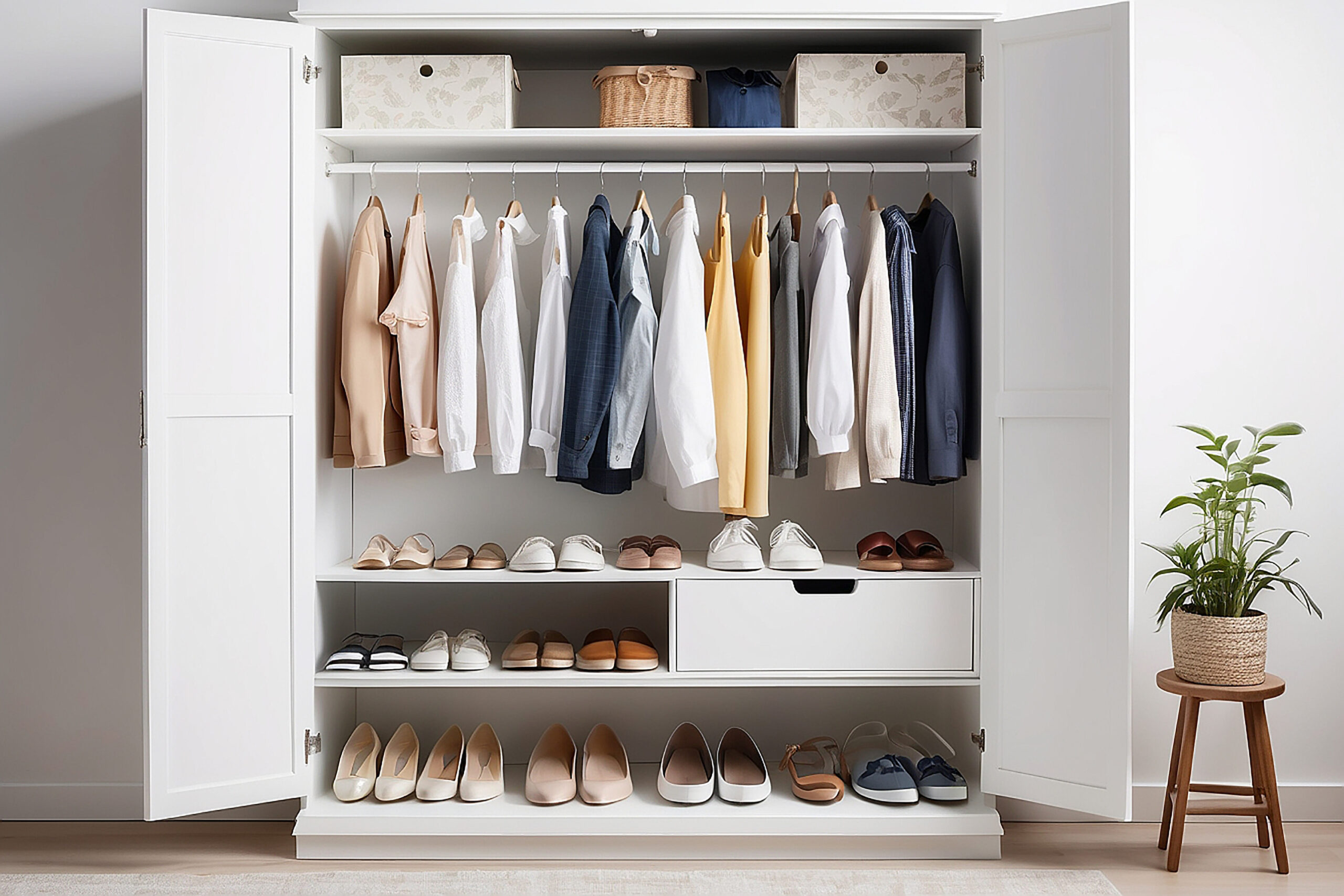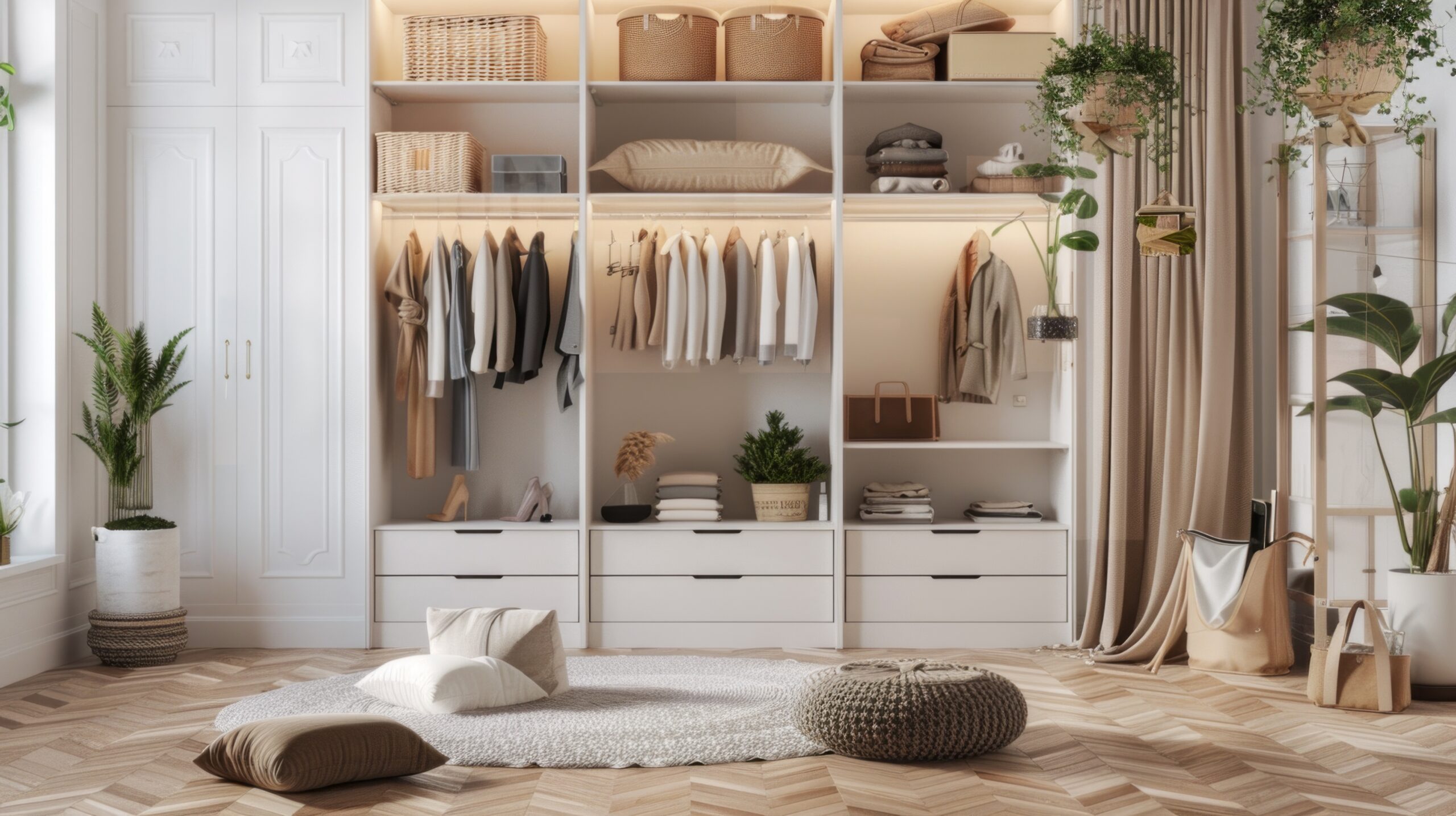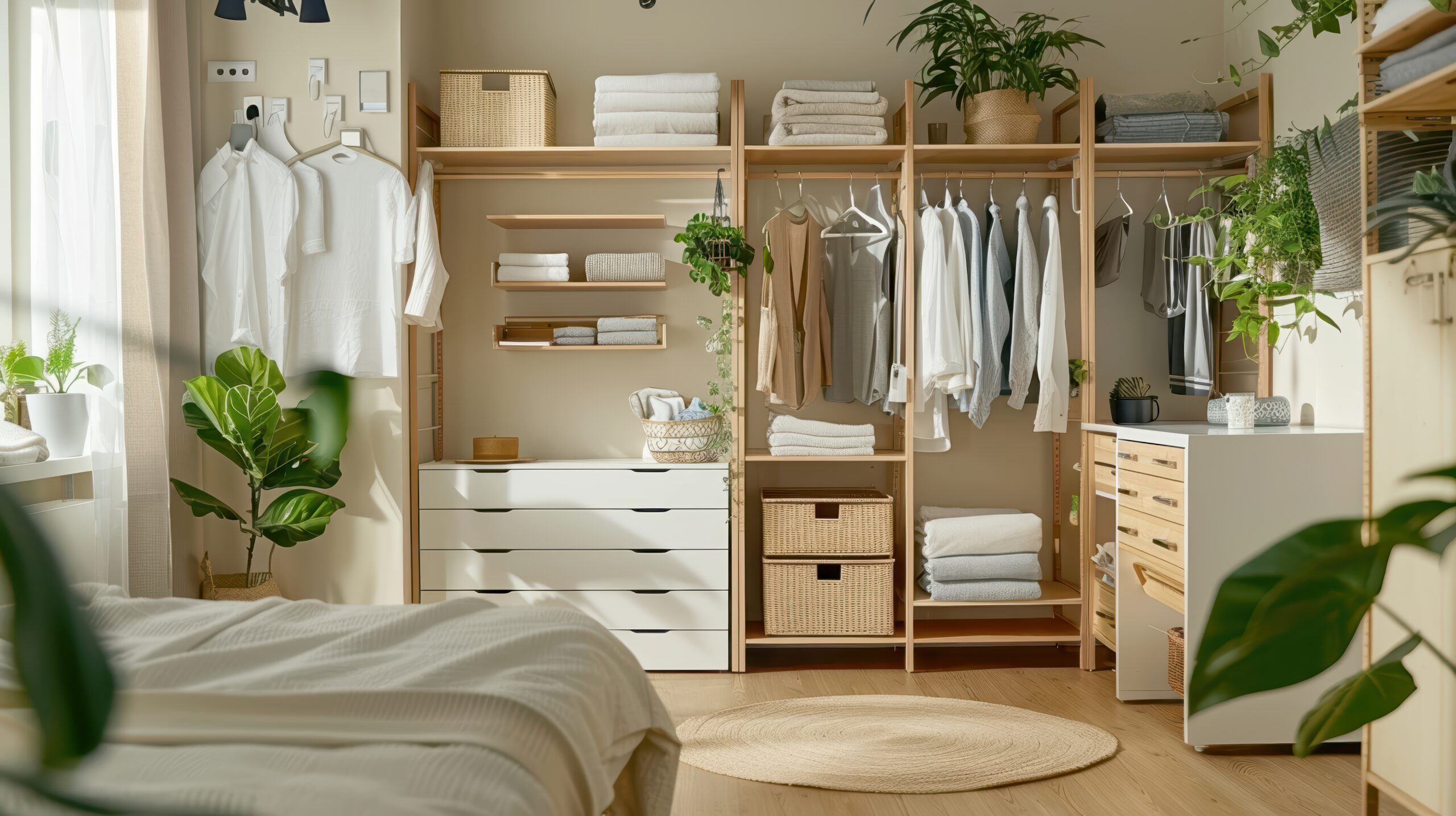Shared wardrobe tips can be followed by home owners or even home renters who are sharing their space with another person to make the process more seamless and organised. Here are 4 great tips to curate a perfect wardrobe sharing scenario.
Shared Wardrobe #1: Knowing Your Needs Within The Space

The most important first step in any design for an effective shared wardrobe is assessment of needs and space. One needs to assess space and understand the required storage needs for each person before any form of organisation can begin.
Once that has been decided, begin by measuring the dimensions of the wardrobe, noting the vertical and horizontal space and any features currently in place such as shelving or hanging rods. This will provide the required view necessary to decide how best to utilise every inch available within the wardrobe. Consider the inventory that is used and required for each person — work clothes, casual clothes and seasonal clothes. Remember to add extra space or storage areas for shoes, accessories and specialty items such as sports equipment or formal wear.
@ampquartz Built-in closet menawarkan penyelesaian penyimpanan yang praktikal dan bergaya dalam sebarang saiz. Lepas je korang dah tentukan saiz closet anda, haa ni ada beberapa petua untuk dipertimbangkan masa korang nak rekabentuk ruang tu! ☝️ 𝐁𝐨𝐨𝐤 𝐜𝐮𝐬𝐭𝐨𝐦 𝐜𝐚𝐛𝐢𝐧𝐞𝐭 𝐣𝐨𝐦! 📞 +6017 732 0149 (Jasmine) +6010 707 7815 (Lekha) https://go.wa.link/ampquartz 📍𝐉𝐨𝐦 𝐭𝐞𝐧𝐠𝐨𝐤 𝐬𝐡𝐨𝐰𝐫𝐨𝐨𝐦 𝐤𝐢𝐭𝐚! Alamat: https://waze.com/ul/hw23bfh9s4 82, Jalan Gaya 1, Taman Gaya, Ulu Tiram, 81800 Johor Bahru 💻𝐓𝐞𝐧𝐠𝐨𝐤 𝐣𝐨𝐛 𝐬𝐢𝐭𝐞𝐬 𝐤𝐚𝐦𝐢: https://www.ampquartz.com/ #fyp #builtincloset #closet #ampquartz
♬ Taste – Sabrina Carpenter
Once it has been known and confirmed on how much storage each person needs, it will be the main base line used to dictate the overall design. For instance, one person might need more hanging space for suits and dresses while the other needs a lot of shelving for folded clothes and bags. The shared wardrobe should meet the needs of its users without creating more clutter or confusion within the area. It is also during this stage that one thinks about the future should the idea of expanding wardrobes for storing new things comes into play.
Also, consider how often you access your items. The items that are looked for more often can be placed in areas that are easier to reach while seasonal or lesser used pieces can be stored in higher places or other corners that are not often frequented. Besides, this will help to divide the space properly and ensure a good accessibility of belongings for both users. By keeping needs and space in mind, you will be setting the foundation for an everyday shared wardrobe that can be functional and versatile — meeting lifestyle needs for both users while maximising space.
Shared Wardrobe #2: Implementing Zoning

Having distinct zones within the shared wardrobe is one of the basis of organisation and the guarantee of ease with which both users can find their belongings. You do not need to go through confusion and navigate through mess when you have properly divided the space between yourself and the other person.
For starters, one can divide it vertically or horizontally as this would give each person a well-defined area for clothing and accessories. This makes it easier to keep track of the items each person possesses while ensuring that the wardrobe is neat. Colour-coded hangers, bins or labels enforce these zones and are easy visual reminders of where things should go. For example, one can use blue hangers and bins and the other person can use pink so that with one look, they know which items belongs to them and the other person.
Also, each zone can be divided further by categorising items such as all types of clothing being grouped together — pants, shirts, jackets as this would further streamline the organisation within the wardrobe. Well-set zones also reduce the chances of losing or mistakenly taking the other person’s belongings. This instills a sense of possession in the space and allows every person to manage his or her section with ease. Besides the issue of practicality, separate zones contribute to a better communal life, as no one gets frustrated due to the lack of organisation and space in a shared wardrobe. In smaller wardrobes, dividers for drawers or separate shelving for things can be used.
Finally, clear and distinct zoning will create order, effectiveness and peace when it comes to the use of the wardrobe — both users will find their items accessible and be assured that their respective personal belongings are in order.
Shared Wardrobe #3: Multifunctional Furniture Choices

In planning and designing a shared wardrobe, it is also important to integrate multifunctional furniture that will help to uplift organisation and space efficiency. Some multifunctional furniture includes modular storage units, foldable benches with integrated drawers and adjustable shelving systems that solve problems and maximise available space for multiple users.
@ampquartz Greige is that perfect mix of grey and beige that’s super versatile for any kitchen style. It’s got the warmth of beige and the coolness of grey, so it gives your kitchen a cozy but still modern and sleek vibe. This color works well with both light and dark accents, whether you're going for a minimalist look or something more bold. it's the ultimate neutral that keeps your space feeling fresh and timeless. 😍✨ #GreigeKitchen #KitchenInspo #NeutraKitchenTheme #HomeDecor #KitchenGoals #ModernKitchen #FYP #AMPQUARTZ
♬ Senopati in the Rain – Jordan Susanto
For instance, a bench with storage might become an easy seating spot but can also tuck away seasonal clothes and accessories out of sight. Likewise, modular storage units can be designed to handle a wide range of wardrobe sizes and configurations —everyone gets a section that is dedicated to themselves while making sure that the space is optimised. This is really helpful in shared wardrobes when one wants to move shelving systems around or readjust the space to meet changing needs in terms of clothing storage. Besides, adding built-in hooks or pull-out racks will allow accessories and other miscellaneous items to remain organised and within easy reach.
When you select furniture that can carry out multiple tasks, you are able to maximise the use of space and develop a sleeker and more functional setting for the wardrobe. This would give a minimalist look and separate areas designated for each respective user would create less chaos in the shared living space. Multifunctional furniture also creates an aesthetic with no clutter — making it easier to find and manage clothes and other items effectively.
Shared Wardrobe #4: Practicing Decluttering Frequently

When it comes to shared wardrobes, among the ways used to keep them organised and efficient is through regular decluttering. Since a number of people are using the same wardrobe, messes and clutter can easily accumulate and eventually spiral out of hand.
It is important that scheduling regular decluttering sessions is done frequently. The process entails assessment and elimination of items that are no longer in use to ensure that the wardrobe remains functional and not too cluttered. The content should be periodically checked to sort out what is old, seldom worn and can be donated or kept elsewhere. This will enable one to easily locate and retrieve items that are still in use. The frequency of clearing can be done every season or once after a few months and this stops hoarding and mess to pile up and allow for the maintenance of an organised and well-kept wardrobe.
@ampquartz Mana orang Johor?!!!📢📣 Ada nak beli custom cabinet tapi tak tahu kat mana? Jomlah datang showroom kami! Bila-bila pun boleh, kita bukak setiap hari! Kita ada buat custom untuk dapur, TV panel, gerobok, rak kasut, dan macam-macam lagi! ✨ 𝙆𝙚𝙣𝙖𝙥𝙖 𝙗𝙪𝙖𝙩 𝙠𝙖𝙩 𝘼𝙢𝙥𝙦𝙪𝙖𝙧𝙩𝙯?🤔 ✨ ✅’Quotation’ Percuma & Lukisan 3D ✅Rekaan Berkualiti Tinggi & ‘Style’ ✅Harga Berpatutan ✅Promosi Bulanan ✅Pelan Ansuran Bulanan 0% 𝐁𝐨𝐨𝐤 𝐜𝐮𝐬𝐭𝐨𝐦 𝐜𝐚𝐛𝐢𝐧𝐞𝐭 𝐣𝐨𝐦! 📞 +6017 732 0149 (Jasmine) +6010 707 7815 (Lekha) https://go.wa.link/ampquartz 📍𝐉𝐨𝐦 𝐭𝐞𝐧𝐠𝐨𝐤 𝐬𝐡𝐨𝐰𝐫𝐨𝐨𝐦 𝐤𝐢𝐭𝐚! Alamat: https://waze.com/ul/hw23bfh9s4 82, Jalan Gaya 1, Taman Gaya, Ulu Tiram, 81800 Johor Bahru 💻 𝐔𝐬𝐡𝐚 𝐰𝐞𝐛 𝐤𝐚𝐦𝐢 𝐣𝐚𝐩: https://www.ampquartz.com/ #kitchencabinet #kitchencabinetjohor #johor #johorbahru #ampquartz
♬ Hip Hop Background(814204) – Pavel
Secondly, clear rules on how the space should be maintained will further enhance organisation. For instance, establish rules on how to store clothes in the wardrobe so that both parties recognise respect for each other's space. Periodic cleaning out will also give the chance to reorganise and readjust the wardrobe setup for needed adjustments as changing needs or personal preferences may dictate. This proactive mindset ensures the shared wardrobe is a functional and pleasant area for the two individuals involved — minimising tension and adding efficiency to daily routines.
Keeping this area clear will enable both users to experience a seamless and peaceful time; thus, making the process less irritating and promoting cooperation in a shared environment.





